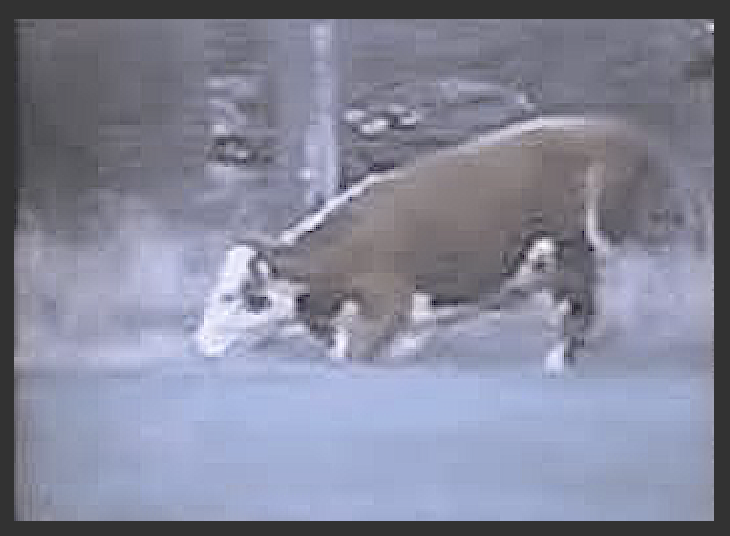.
An Outbreak of Industrial
Fluorosis in Cattle
by
H. H. Green, D.Sc.
” A Discussion on Fluorosis in Man and Animals”
In February 1941 the occurrence of severe fluorosis in cattle was described on farms in the vicinity of brick works in Bedfordshire.
The purpose of the present communication is to report a similar occurrence associated with the calcining of ironstone in Lincolnshire.
In this process the raw ironstone is mixed with about 7%/of its weight of coal and ignited in the open, fresh layers being added to form a smouldering mound, the complete calcining of which occupies several weeks.
The weight of the ironstone is so reduced for transport, and the ore rendered sufficiently porous for direct reduction in blast furnaces at distant smelting centres.
During the calcining process smoke drifts on to neighbouring farms, and on the nearest of these an obscure disease of cattle was reported by G.A.Moore, M.R.C.V.S. Samples of urine from affected cases, analysed at Weybridge, at once established a diagnosis by revealing 26 to 69 parts per million of fluorine. Analyses of materials collected during a visit to the area showed 1,200 p.p.m. fluorine in the ironstone itself and 100 to 180 p.p.m. in. the various types of coal used.
.
The calcined ore contained only 300 p.p.m., thus revealing a loss of three-quarters of the original fluorine or about four-fifths if loss of weight be allowed for. Imitation of the calcining process in the laboratory showed approximately 90% loss of fluorine at controlled muffle temperature of
8500 C., but negligible loss at 6000C. It seems probable that the fluorine comes off as silicon fluoride which, reacting with atmospheric moisture and ammonia from the coal, condenses on the smoke particles as ammonium fluoride and silico-fluoride and drifts on to the pastures. Samples of water from the affected farm showed only 0-5 p.p.m. fluorine but grass samples within a few hundred yards of the burning mounds showed over 2,000 p.p.m. on the dry matter. A straw stack about half a mile away showed 490 p.p.m. on the exterior and 70 p.p.m. in the interior. The danger zone has not yet been mapped out but it is not likely to exceed a radius of 2 miles.
‘Proc.R.Soc.Med.,34,391.
796 Proceedings of the Royal Society of Medicine 32
Cattle on the nearest farm were stunted and lame and the owner described some of the earlier cases as having to be destroyed after “crawling on their knees”. Two cases have been purchased for post-mortem study by F. Blakemore at Cambridge and will doubtless show lesions similar to those described in 1941.
The human family on the same farm is a large one and urine samples of 9 people showed from 13 p.p.m. to 4-2 p.p.m. fluorine, averaging less than one-tenth that of the cattle urines but nevertheless being above normal and far above the value in the drinking water.
Surface contamination of green vegetables is suggested as the source.
Dr. Dagmar Wilson has been asked to consult with the local M.O.H. with regard to clinical symptoms in the children.
Dr. Dagmar Wilson: Our knowledge of human fluorosis has been considerably extended since fluorine was the subject of discussion by this Section in 1941. Fluorine is now generally recognized as an important trace element in human nutrition which exerts influence at non-toxic as well as at toxic levels.
The incidence of fluorotic lesions probably bears a definite relation to the economic and nutritional status of a community. A small amount of fluorine-under 1.0 p.p.m.- is present in many British water supplies and a lowered incidence of dental caries is found amongst people who have used a drinking water containing 0-5 to 1-0 p.p.m. fluorine for at least the first eight years of life. In the United States fluorination of water suppliesis being considered for the partial control of dental caries. Human balance experiments show a close correlation between fluorine in the drinking water and in urine, and the elimination of fluorine is practically complete when the quantity absorbed does not exceed 5 mg. daily. In human toxic fluorosis acute generalized and local effects are usually accidental.
Chronic poisoning in man occurs in two ways, as chronic endemic fluorosis and as an occupational disease.
Bone abnormalities and systemic illness, of which gastric derangement is an early sign, may occur when fluorine tolerance levels are exceeded.
Fluorides are being increasingly used in industry and large amounts of fluorine are associated with recent industrial development in this country. Methods for the control of the fluorine evolved are known and are not difficult of application, but the fluorine hazards for factory workers, for their families living near-by, and for other people resident or employed in the neighbourhood, as well as for the animal population, are not sufficiently appreciated.
Dr. Margaret M. Murray: In 1937 when Roholm’s book “Fluorine Intoxication” was published and reviewed, my attempts to interest appropriate persons in the possibility of a fluorine hazard to human beings in Great Britain, particularly in the Scottish High-lands, failed. [well – well, what a surprise]
Since then we know of three outbreaks of fluorosis in farm animals and it is significant that in each case it was the effects on grazing animals which brought to light the existence of the fluorine hazard; consideration of the effects on human beings has in each case been secondary.
We owe it to Dr. H. H. Green and his colleagues that the cause of the outbreak in the Marston Valley was discovered and the plans for elimination of the danger were successfully worked out.
At Fort William it was because sheep in the vicinity of the aluminium works did not thrive at and inquiry was made into the question of a hazard to human beings. Examining school children at Inverlochy, which has only 0-2 p.p.m. fluorine in the drinking water and which is situated in the direction of the prevailing wind carrying the fumes from the aluminium works, Dr. Wilson and I found the white mottling of dental fluorosis present even in the temporary teeth. We were, and still are, at a loss to explain what was the source of the fluorine which caused this mottling, particularly of temporary teeth.Dr. Green’s investigations show the fundamental importance and usefulness of the determination off fluorine in urine in the study of fluorine intoxication.
These outbreaks of fluorosis in farm animals have also shown that not all animals are similarly affected by the ingestion of toxic amounts of fluorine. In-cows the long bones are severely affected, while in the sheep at Fort William, investigated by Professor Boddie of the Royal Dick Veterinary College, Edinburgh, it was the jaw bones which were grossly abnormal and because of this the animals could not obtain food. This is the condition seen in the sheep, goats, camels and horses of the “Darmous” region of Morocco. In man it is usually the vertebral column which is first affected and this effect may not be detectable until there has been a long period of exposure.
Therefore, in the absence of positive X-ray findings, the only means of testing for the ingestion of fluorine at levels which will ultimately cause these bone changes, is by the determination of fluorine in the urine.
REFERENCE
BODDIE, G.F.(1945) Chronic Fluorine Intoxication in Sheep and its Effect upon the Teeth, Proc. Nutr. Soc.,3,94.
Reproduced by:
Fluorosis in Cattle
People Drinking “Natural” Fluoride








